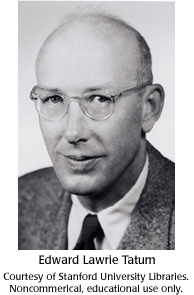Concept 16 One gene makes one protein.

 George Beadle had successful research careers in corn and Drosophila genetics, before starting the field of Neurospora research. George Beadle and Edward Tatum used Neurospora to prove that "one gene makes one protein." Tatum also had a role in starting bacterial genetics.
George Beadle had successful research careers in corn and Drosophila genetics, before starting the field of Neurospora research. George Beadle and Edward Tatum used Neurospora to prove that "one gene makes one protein." Tatum also had a role in starting bacterial genetics.
Edward Lawrie Tatum (1909-1975)

Edward Tatum was born in Boulder, Colorado. While Tatum was growing up, his family moved a number of times. His father had different teaching positions at various universities and colleges in the Midwest. Tatum grew up in a science-oriented household as his father had a Ph.D and an M.D.
Tatum obtained a Bachelor's degree from the University of Wisconsin in 1931, and he stayed to do graduate work on nutritional requirements of different bacterial strains. This research had a practical aspect. The bacterial strains Tatum worked on were found in milk. By knowing what bacteria needed for growth, strategies could have been developed to control their growth.
After his Ph.D., Tatum spent a year at the University of Utrecht, Netherlands, doing the same type of research. In 1937, his professors at Wisconsin forwarded him a job ad. George Beadle was looking for a research associate for his new lab at Stanford University. The job was an excellent research opportunity; however, Tatum's professors advised him to go into the dairy industry and do butter research - the money was better.
Tatum chose intellectual challenge over money. He spent the first few years in Beadle's lab isolating and identifying the "substances" involved in Drosophila eye color determination - an extension of Beadle's earlier work. They were beaten by another group, but this set into motion the events leading up to the Neurospora experiments. The switch to Neurospora supposedly came about after one of the biology classes Tatum volunteered to teach. Beadle was sitting in on the lecture and was reminded of the Neurospora system; he thought it would be the perfect system to use to study gene action.
The new Neurospora project had no guarantee of success. So, Beadle and Tatum had a deal; they would test only 5,000 Neurospora cultures. If they couldn't find one nutritional mutant in 5,000, they would abandon the project. The experiment was a success and Edward Tatum shared the 1958 Nobel Prize in Physiology or Medicine.
In 1945, Tatum had a short stint at Washington University in St. Louis, and then moved to Yale. He was using the Neurospora strategy to find genetic mutants in bacteria. He used Escherichia coli strain K12 from the Stanford collections. At the time, K12 was not the most common E. coli strain in use, but this proved to be a fortuitous choice. K12 had the properties that allowed Tatum and his student Joshua Lederberg to demonstrate bacterial recombination. Lederberg shared the 1958 Nobel Prize in Physiology or Medicine.
In 1948, Tatum returned to Stanford and in 1956 was appointed the head of the new Department of Biochemistry. In 1957, Tatum left to accept a professorship at the Rockefeller Institute and stayed until his death.
Tatum was a very supportive boss. He had his own goals for his lab, but never failed to actively encourage his students in their research interests. He was on the editorial board of science journals such as Genetics, Science, and the Journal of Biological Chemistry. Tatum also served as scientific advisor on many boards and helped set the national policy on training for students and post doctoral fellows. Tatum died in 1975 from heart failure complicated by emphysema from a lifetime of cigarette smoking.


Three years after the Neurospora paper, George Beadle became aware of the work Archibald Garrod did on alkaptonuria in 1902. Beadle saw the similarities and credited Garrod with being the first to work on the "one gene/one protein" theory.

In 1902, Archibald Garrod proposed that diseases are "inborn errors of metabolism." Why wasn't Garrods' theory well-known and accepted in 1902?
 DNA and proteins are key molecules of the cell nucleus.
DNA and proteins are key molecules of the cell nucleus. One gene makes one protein.
One gene makes one protein. A gene is made of DNA.
A gene is made of DNA. Bacteria and viruses have DNA too.
Bacteria and viruses have DNA too. The DNA molecule is shaped like a twisted ladder.
The DNA molecule is shaped like a twisted ladder. A half DNA ladder is a template for copying the whole.
A half DNA ladder is a template for copying the whole. RNA is an intermediary between DNA and protein.
RNA is an intermediary between DNA and protein. DNA words are three letters long.
DNA words are three letters long. A gene is a discrete sequence of DNA nucleotides.
A gene is a discrete sequence of DNA nucleotides. The RNA message is sometimes edited.
The RNA message is sometimes edited. Some viruses store genetic information in RNA.
Some viruses store genetic information in RNA. RNA was the first genetic molecule.
RNA was the first genetic molecule. Mutations are changes in genetic information.
Mutations are changes in genetic information. Some types of mutations are automatically repaired.
Some types of mutations are automatically repaired.